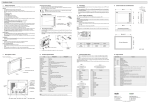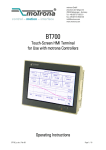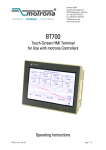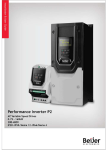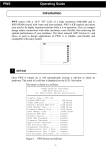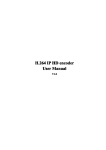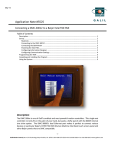Transcript
Operating Guide 1 Introduction 3 PWS6600 comes with a 5.7” STN Liquid Crystal Display, and is water- and dust-resistant according to IP65. The PWS is CE-marked and meets your need to be highly transient-resistant while in operation. Also, its compact design makes connections with other machinery more flexible, thus achieving the optimal performance of your machines. ADP is used to design applications of the PWS; it is reliable, user-friendly and compatible with many models. The latest released ADP Version 6.1 and above can be used to design applications for the PWS. 2 System Menu 5 Set the dip switch SW7=ON. After the self-test, the system menu of the PWS is displayed on the screen: Self Test The bench test performs an overall hardware test and the function test lets the user select which item to be tested. Human Machine Interface ROM BIOS Version 2.1 Copyright 2011 256K Bytes 256K Bytes 512K Bytes 4M Bytes Passed Passed Passed Passed Passed Passed Passed Passed Passed 11011111 8 Downloading an Application Connect the RS232 port on the PC to the COM1 port on the PWS using a WPC-P8-42 cable. The connection can also be made according to the illustration below. PWS-COM1 9-pin male Once the PWS is turned on, it will automatically execute a self-test to check its hardware. The result of a selftest is displayed on the LCD. See below for items to check in a self-test: Display Type = Mono STN LCD System RAM Size ........... Video RAM Size ............ Battery Backed RAM Size ... Application Memory Size ... Working RAM Test .......... Battery Status ............ BIOS ROM Checksum ......... Firmware Checksum ......... Application Checksum ...... RTC Function Test ......... Parameter Checksum ........ Communcation Port 1 Test .. Communcation Port 2 Test .. DIP Switches Setting(8..1)= Bench and Function Tests Set the dip switches SW3 and SW4=OFF to be able to run the bench and function tests for the PWS. Turn on the PWS and the following screen will be displayed. RXD TXD GND RTS CTS PC COM RS232 9-pin female 2 3 5 7 8 Note: The bench test will clear the application data of the PWS. The functions of the commands are briefly explained below: System Menu 6 Function Setting Communication Parameters There are two ways to configure working parameters; to set parameters in the PWS or in ADP. To set parameters in the PWS, select F2 - Confg in the system menu. Link The PWS is connected. F2 - Confg Sets up the internal time clock and communication parameters in the PWS. All the settings has to be made for the PWS to work properly. Note: Remember to set the dip switch SW5=ON if parameters are set in the PWS. Use field. To set parameters in ADP, select Application / Workstation Setup. Then select the Connection tab to set communication parameters. , , and to move to desired field; + and - to set the value of the F3 - Copy Copies application data to the other same model of PWS. F4 - Set Calibrates the touch screen, adjusts LCD contrast and clears RAM data. F5 - Run Runs the application. 4 Note: Remember to set the dip switch SW5=OFF if parameters are set in ADP. 7 Keypad The six keys on the PWS include one menu key and five functional keys (F1 -F5). Press the menu key to slide out the innovative slide-out menu. For further details on the slide-out menu please see the ADP User’s Manual Menu Key If any of tests does not pass the self-test, it will be noted with “Failed” next to the test item. Additionally, the message “Error! Press screen to continue” will be displayed at the bottom of the screen. If the power to the PWS or the PC was interrupted while downloading, Firmware checksum or Application checksum will not pass the self-test, indicated by “Failed” in the self-test results after power is restored. If this happens, the user can simply follow the download procedure to re-download the application or data. After downloading again, all items should pass the self-test. 2 3 5 1 4 6 7 8 PWS ---- PC COM RD SD SG CD DTR DSR RTS CTS PWS-COM2 25-pin male TXD RXD GND RTS CTS PC COM RS232 9-pin female 2 3 7 4 5 2 3 5 1 4 6 7 8 PWS ---- PC COM RD SD SG CD DTR DSR RTS CTS Warning: To avoid an electronic shock, be sure to switch off the power before connecting the download cable to the PWS. Set the dip switch SW7 = ON. After the self-test, the system menu will be displayed on the screen and the PWS is ready to download the application. Start ADP and open the application file to be downloaded. Make sure that the communication parameters are correctly configured. Also remember to compile the file before downloading it. The file has to be compiled every time a change has been made in the file before downloading it. Then select Application/Download Firmware and then Application in ADP if it is a first time to download the application to the PWS; otherwise, select Application/Download Application. The following appears on the screen while the PWS is downloading: Adjusting Touch Panel 1. 2. Touch the upper-left and lower-right corners of the screen. Next follow the route on the screen. 3. Lastly touch the square on the center of the screen to complete the task. Note: Click Clear Data Ram of Set Key,the data stored in RAM will be erased. F1-F5 Keys When a key is pressed, the PWS will make a “beep” sound to signal that a command is pressed. (The default setting is a 200 ms beep, and can be configured.) 9 10 Uploading / Downloading a Recipe 12 Setting a Password Scenario 3: Password-protecting a button in the PWS An application can also be uploaded from the PWS to the PC. Thus, a user can save an application as a *.V6F file in ADP for future use. Uploading an Application Set the dip switch SW7 = ON. After the self-test, the system menu will be displayed on the screen and the PWS is ready to upload/download a recipe. Scenario 1: Requiring a password to start the PWS Warning: To avoid an electric shock, be sure to switch off the power before connecting the communication cable to the PWS. Make sure that the PWS and the PC are connected according to section “Downloading an Application”. Set the dip switch SW7 = ON. After the self-test, the system menu will be displayed on the screen and the PWS is ready to upload the application. Also make sure that communication parameters are correctly configured. Select File/Upload Application in ADP and the Save As dialog box will appear on the screen. Enter the name of a firmware file (*.AF6) to save. Click Save. Then the PWS will prompt for a password: enter the password set in ADP from Application/Workstation Setup. Once the correct password is entered, the PWS starts to upload the application to the PC. For information about setting a password, please see section “Setting a Password“. While the PWS is uploading, the following is displayed: Uploading a Recipe The ADP can create a button which is protected by a password for execution. For example, a Goto Screen button can be designed with a high level of security; which means that a password with a high level of privilege is required in order to open the other screen. As the button is selected and the current user has a lower privilege than has been set for the button, the PWS will prompt the user for a password. The user will need a password with at least the level of privilege that has been set for the button. This function can restrict users to access to certain parts of the application. Select File/Upload Recipes in ADP and the Save As dialog box will appear on the screen. Enter the name of a recipe file (*.RCP) to save. Click Save. While the PWS is uploading the recipe, Uploading recipes is displayed on the screen. Note: When using the PWS for the first time, make sure to first run the application once, or else the upload function will not work. Scenario 4: Requiring a password to copy or upload application Downloading a Recipe When selecting F3 - Copy in the system menu or File/Upload Application in ADP, the PWS will prompt for a password. The user will need to enter the correct password to copy an application from one PWS to another. Note that setting this password is different from the passwords set in Scenarios 1-3. To set this password, select Application/Workstation Setup in ADP. Under the Password tab, the project designer is able to set the password. Open an application file with the recipe to be downloaded in ADP. Select File/Download Recipes to display the Open dialog. Enter the name of the recipe file (*.RCP) and click Open. While the PWS is downloading the recipe, Downloading recipes is displayed on the screen: Uploading recipes Link After uploading, select File/Reconstruct Source in ADP to display the Open dialog. Open the uploaded application file (*.C64 or *.AA6). The application screen will be displayed on the PC monitor. Finally, select File/ Save As to save the application as a *.V6F file. Thus a source file can serve the purposes of maintenance and modification. If the dip switch SW6 = ON, the user needs to enter a password to start the PWS. For this purpose, the designer can use the object Action Button in ADP to create a button which displays the password table on the PWS display. A user with the right to access the table can register passwords and user levels in the table. Downloading recipes Link After the download is finished, select F5 - Run to run the application. Remember to define the length and the number of recipes in the application. Also remember to upload the format of recipes from the PWS before starting to edit a new set of recipe data in the PC. For further information about creating/editing recipes, please see the corresponding chapter in the ADP User’s Manual. 11 Copying an Application To copy an application from one PWS to another, select F3 - Copy from the system menu. Set the dip switch SW7 = ON and connect the two PWSs with a download cable. After the self-test, the system menu will be displayed on the screen. Select F3 - Copy in the system menu from the PWS with the application to be copied. The PWS will prompt for a password: enter the password set in ADP from Application/Workstation Setup. Once the correct password is entered, the PWS will start to copy the application between the two PWSs. In the illustration above, the TBL-button is an action button used to display the password table. When the button is selected the password table is displayed on the screen for a user with the right to access the table. Touch the password to highlight an area for entering a value. How to configure an Action Button is described in the ADP User’s Manual. After registering passwords and user levels, set the dip switch SW6 = ON (i.e. password required). Restart the PWS and after the self-test the user will be prompted to enter a password in order to run the PWS. The PWS will determine the user level from the entered password. For instance, if the level of the password entered by the user is 2, then the PWS will set the user level to 2. User level 1 has the highest privilege and User level 9 has the lowest. Note: Only users of User Level 1 has the right of access to the password table. Scenario 2: Re-entering a password The object Action Button in ADP also allows the designer to create a button which asks the user to re-enter a password. For example, by pressing the PSW-button the password keypad will be displayed to prompt the user to enter a password. After entering the password, the PWS will update the user level according to the most recent password which has been entered. Therefore, this button can be applied to raise or drop one’s privileges while the PWS is in operation. The following appears on the screens during the copying: Note: When copying for the first time,make sure to first run the application once, or else the copy function will not work. How to configure an Action Button is described in the ADP User’s Manual. Beijer Electronics AB Box 426 SE-201 24 Malmö, Sweden Tel: +46 40 35 86 00 Fax: +46 40 93 23 01 www.beijerelectronics.com Beijer Electronics Corp. 8F., No.108, Minquan Rd., Xindian Dist., New Taipei City 23141, Taiwan (R.O.C.) Tel: +886-2-2218-3600 Fax: +886-2-2218-9547 www.beijerelectronics.com.tw 07/25/2011/V.6 660018+06
